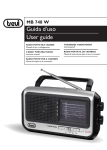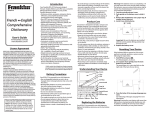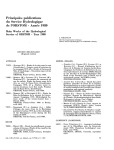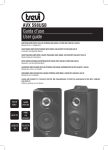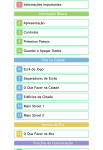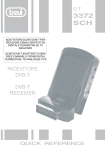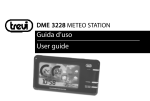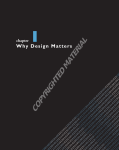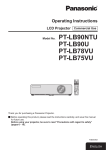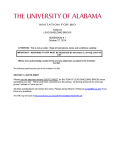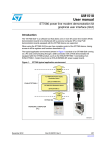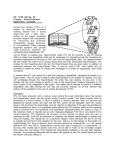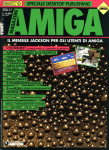Download Latin Flash Drill 4.5 - J
Transcript
Dear Colleague
I have decided this year, for the first time, not to send out printed catalogues to our
customers. This is for reasons of environmental impact, time and materials: beyond that,
a printed document can become out of date all too soon. Since most of you have easy
access to online resources these days, it seems best to make our catalogues available as
downloads from our website. However, should you particularly want to receive a printed
catalogue by post, please feel free to request one and I will do the rest.
During the last twelve months there have been many changes in my own circumstances. I
am now teaching Latin at the European School in Karlsruhe, Germany, and living in
Alsace, France. Whilst I am enjoying my new life, I hope that J-PROGS customers will not
notice much difference, in terms of making contact, asking questions or placing orders.
Please note the new business address in this flyer and ensure that any orders are sent to
the correct place.
Our first major new program for 2008 is The Horace Trail 2, a revamped version of the
Horace Trail, published in 2002 by Oxford University Press. You will note that the new
version makes the program into a typical J-PROGS product, with integrated quizzes and
networking systems, allowing for targeted use with students. This is a high quality
product with an excellent pedigree, which I hope you will enjoy using.
The second major announcement is that download licences of Latin Vocab Drill
and Latin Flash Drill can now be bought in packs of 10. At a cost of £3 per download,
there has never been a better time to introduce this software into your schemes of work.
The one restriction is that your school must own a site licence first, before being allowed
to purchase download licences.
J-PROGS continues to serve as an approved content provider and retailer for Curriculum
Online. This means that software purchases for schools in the UK’s maintained sector can
be made using eLCs, or eLearning Credits. If you teach in a state school, find out who is
the eLC budget holder and make a request for funding for software purchases to that
person, to ensure that the Classics department gets its fair share of the allocation.
If making an order, please check whether you are eligible to claim an upgrade discount.
If you are in doubt, please email or ring up to ask. I look forward to making contact with
you in 2008 and hope you will let me know if any of your contact details have changed:
the database can only stay current with your help. Various resources are available on our
website, so please delve around and use what you can find there.
I will continue to work in 2008 to create new products and maintain existing titles in our
range. Please keep in touch if you need advice: the best way is usually by email. For the
time being, please remember that we are now able to process payments by credit card
online.
Julian Morgan
The Horace Trail 2
The main research for the Horace Trail
was done in 2002, when an analysis of the
whole corpus of Horace’s writings was
created, before journeys were undertaken
to Italy, Greece and Turkey. The intention
was to visit and include every place
mentioned in the poems. The Horace Trail
was published by Oxford University Press
and was used and enjoyed in many
schools and colleges. It benefited from
around 400 JPEG images, which could be
accessed from the CD and used in
electronic assignments.
New for 2008, we have updated the earlier
work and brought it under our own
J-PROGS umbrella for publication.
The Horace Trail 2 is more compatible
with modern systems than before, and has
been given new functionality, including
customisable quizzes using our Quizbuilder
system, first developed for use in our
programs Pompeii and Greek Gods.
Version 2 of this software benefits from:
Various replacement photographs and minor interface improvements
Quizbuilder system allowing users to test themselves on any of the major sections
of the program, building randomised quizzes based on a database of questions
Level 1 quizzes allow for multiple
choice selections to be made
Level 2 quizzes require answers to be
typed in full
Networking capabilities, allowing
scores to be logged and consulted
on modern systems (Read/Write
access must be provided to allow all
the systems in the program to work)
Password protection for score
handling features
Enhanced interactivity, with
responses given to names supplied
by the users
Compatibility with Windows XP, Vista and Mac OSX systems
Easy Latin Puzzles
Easy Latin Puzzles is a collection of 50 puzzles, varying from simple crosswords to
word searches, arrow words, sudokus and cryptic mind benders.
The puzzles are all based on a set of vocabulary
created by analysing a range of early chapters
of several of the most popular Latin courses
today. They should be accessible to early
students of Latin, as well as to adults whose
recollection of Latin from their quondam days
may be a little hazy.
Easy Latin Puzzles does not make use of
Latin endings systems, which is how we can
justify calling it Easy. For those of you who get
stuck, vocabulary lists and answers can be
found at the back!
Easy Latin Puzzles can be bought as a single
book or a set of five. It can also be bought on
CD-ROM, with a licence to print any of the
pages in the establishment making the
purchase. To give you an idea of what you can
expect, here is a puzzle for you to try out now.
VII
III VIII
VI
VII
III IX
III
II
IV III
II
IV
VIII V
VI
VII
IX
VII
IX III
II
I
VIII
V
I
V
VII III
III VIII
I
II VIII
IX
I
Greek Gods
Greek Gods has different sections on Origins, Heroes & Monsters, the Gods, Temples &
Worship, Festivals and the Oracle at Delphi. All sections are fully illustrated from the
J-PROGS photo archive.
Interactive quizzes provide feedback as users choose how many questions they wish to
attempt, from any of the sections studied. The Quizbuilder system allows students to
make a quiz for themselves based upon the sections of the program they choose to
include. Quizzes built can be multiple choice (Level 1) or require a full answer to be typed
(Level 2). The number of questions can be set at anything from 5 to 50, depending on
how many sections have been included. Scores can be kept on networks or hard drives
where permissions can be set to make this possible: if in doubt, please ask for advice
about this.
Greek Gods should be accessible for students of ages 11 to 16. At the upper end it
should support learning of materials for public examinations, including Classical
Civilisation GCSE.
Pompeii
This program is the product of many hours of research and on-site visiting. Pompeii
boasts an interface which has been designed to make exploration of the town simple and
fun, featuring all of its best known buildings.
The Contexts section considers the development of the town, its eventual destruction by
Vesuvius in AD 79 and its subsequent discovery by archaeologists. The Focal Points section
looks at public areas including the forum, theatre district and the amphitheatre. The
Buildings section looks at fountains, shops, streets, temples, tombs, walls, gates and the
water supply. A section on Houses looks at eight of the better known houses in the town,
and a final section on Art considers examples of mosaics, statues and wallpaintings. All
parts of the program are illustrated by original photographs.
Interactive quizzes test student progress and users can choose how many questions they
wish to attempt, from any of the sections studied. Progress through the quizzes is logged
and scores are recorded to a hard disc or network, where this option is enabled.
Pompeii Suite
The Pompeii Suite allows you to buy a site licence for Pompeii and the Pompeii Photo
CD at a combined, reduced rate. This will equip your school and your students with an
exceptional set of resources for further study or coursework, at a very advantageous price.
Latina 4.5
Latina 4.5 is the name given to the CD-ROM on which the latest versions of Latin Vocab
Drill and Latin Flash Drill are found. These are two of our most popular programs,
available in many different modules, keyed to most major Latin syllabuses and courses.
Our new download licences can bring the price down as low as £3 per student, per
module. See Order Form for details.
The Latina 4.5 upgrade is FREE online to all Latina 4.0 licence owners.
For details, see the Updates section on the Support menu, at www.centaursystems.com.
New improvements for 2007 are:
• greatly improved scorekeeping, in a new easy-to-read, printable chart format;
scores can be sorted by any category; other users’ scores are hidden from all but
the teacher/password holder.
• new Details page shows all details on a single drill for easy review and printing.
• new diagnostic options for LVD 4.5 allow for the creation of customised word lists
for specialised revision and review by each user.
• new diagnostic options for LFD 4.5 allow users to maintain a checklist of all
recorded drill work by grammatical category, to determine acceptable proficiency
and guide future menu selections for each user.
Latin Flash Drill 4.5
Latin Flash Drill 4.5 is an advanced system for drilling grammatical forms and for making
a self-diagnosis of where help and practice is most needed. Version 4.5 allows
randomised drills on form creation and paradigm charts. Just specify which parameters
you want to review and the program will drill you on individual forms from those sets,
combined together into one session of work. Different modules are correlated to most
major Latin textbooks and syllabuses, including Cambridge Latin Course, Ecce Romani,
OCR GCSE, OCR AS Level, Oxford Latin Course and Reading Latin.
"When our Latin Flash Drill
software was erased during a
network renovation, our
students switched to using drills
from the Internet. They much
prefer the Centaur ones and
want them back ASAP. Smiles."
Geraldine Kuenkler,
Valley Regional High
School,
Deep River CT
Latin Vocab Drill 4.5
Latin Vocab Drill has been used successfully all around the world since 1987. Different
modules are correlated to most major Latin textbooks and syllabuses, including
Cambridge Latin Course, Ecce Romani, OCR GCSE, OCR AS Level, Oxford Latin Course and
Reading Latin.
“Latin Vocab Drill . . .
makes learning
vocabulary a lot easier
and makes the learning
process hassle-free and
fun.”
George Artley, Times
Educational
Supplement Online,
January 3, 2003
Version 4.5 now includes a review list option, where users can build lists of their own from
complete syllabus vocabularies and see the words disappear gradually away from their
own revision lists as they get their answers right.
Version 4.1 included simple in-program data-editing option for quick editing and case
sensitivity option that can be used to distinguish macrons in files that have been edited
for this purpose.
Version 4.0 included a quiz-making facility, simplified networking, straightforward
interface and multiple drilling formats.
Record-keeping facility allows for optional recording and printing of scores for
accountability. LVD 4.5 offers the following drill options, commands, and conveniences:
•
•
•
•
•
•
•
•
•
•
diagnostic aids to syllabus-wide revision
drills from Latin to English or English to Latin
percentage scoring optional
drill ALL listed principal parts or just the first one
English derivatives and other hints available during drill
drill words in listed or randomised order
reference vocabulary lists for study (scoring penalty)
skip to next item when stuck (scoring penalty)
ability to quit program or go back to menu at any time
help screen provides online user manual
The program shell remains the same for all course-specific versions and different modules
can be bought at different times, making this an extremely flexible resource.
Aeneas 3
Aeneas 3 is the latest incarnation of a well-established J-PROGS title. The program has
three main sections:
•
•
•
the story of Aeneas' travels from Troy to Italy, told with animations and cartoons
information on Vergil and the Aeneid
a Latin version of the story, told in language which has been directly adapted from
Vergil's original
The Latin stories consist of about 500 words, broken into 15 screens. These are aimed at
year 10 students or above. Each passage can be heard read aloud, as sound files are
attached. A full range of information is given about each word under the headings
vocabulary, syntax and grammar. Translations are also available. The program stores the
information accessed, keeping a log of how much help the student has used. After the
work is completed, a record is saved to the hard disk of the full session. This can be
loaded into any word-processing application and printed so that, for example, the
student can work towards learning unknown vocabulary.
A new feature in Aeneas 3 allows teachers to specify how much help should be accessible
to students. For example, vocabulary help can be limited to 10 words, or translation help
can be allowed from zero times to any number. This sophisticated system gives the
teacher a great deal of control over the process, ensuring that students concentrate on
areas which are of most benefit to them. The Status card system shows how much help
students have sought and even identifies areas of grammatical weakness, which they
should consider revising.
Roman Technology 4.1
Roman Technology 4.1 is the latest version of
this program, which we first published in
1993 after consulting carefully with advisory
teachers of science. It has been used in
various museum displays and a special
adaptation of it is currently in use in
Canterbury’s Roman Museum.
It features 3-D modelling and animations,
giving a clear and obvious idea of how
different technologies worked.
The program is suitable for pupils who have some or no familiarity with this material and
assumes no prior knowledge. It is an extremely useful aid to revision of material, which
has already been learned. A collection of around 270 JPEG images is included, which can
be used in student assignments or websites, though some copyright restrictions do apply
to their use.
The content of Roman Technology 4.1 has been chosen for its relevance to the modern
world, as well as its importance in the Roman context. Many photographs used were
taken in locations around Europe. All models and illustrations used are originals, based
on primary sources.
Wherever possible, connections are made to the modern day, to our linguistic and
cultural heritage drawn from ancient Rome. Sections are Aqueducts, Arches, Baths,
Building Styles, Machines & Weapons, Measurement, Roads & Transport and
Timekeeping. The key to moving around within the stack is the Main Index card, where
you start off, and to which you can return from almost anywhere else.
“... young learners are visually sophisticated these days and this program takes this into
account …….I was particularly impressed by the Porta Nigra at Trier, the Arch of
Diocletian at Sbeitla and the bridge at Merida, Spain.”
Bob Bass, The Journal of Classics Teac hing, Summer 2004.
Photos, Photos, Photos
We are pleased to publish five collections of photographs, to be used in both printed and
electronic assignments, including presentations and websites. Some copyright restrictions
apply and the images may not be used for commercial gain. All pictures are of high
quality: most are scanned at about 1200 pixels wide, with a resolution of 300 dots per
inch (dpi). They can be used in full screen displays and printed at professional quality at
a reasonable size. Text files are included, as an index for the images, which are
keyworded to make it easy to find artefacts or thematic subjects.
Pompeii Photo CD
The town of Pompeii is superbly documented in this collection of more than 900 pictures,
with folders as follows: Amphitheatre, Baths, Bodies, Forum, General views, Houses,
Mosaics, Palaestra, Shops, Streets, Temples, Theatre district, Tombs, Various,
Wallpaintings, Walls and gates, Water and fountains. This CD can be bought together
with Pompeii, as the Pompeii Suite.
“… yet another must-have collection…
this collection is excellent value and
warmly recommended.“
Bob Bass, the Journal of Classics
Teaching, Spring 2006
Hellenika Photo CD
The Greek world is presented in this collection of around 1000 pictures, with a rich
collection of sites, buildings and facilities in Greece and some of its most important
islands, Cyprus, Italy and Turkey. There are seven main folders containing images, which
are Elgin Marbles, Islands, Italy & Sicily, Mainland Sites, Personalities, Turkey, Various.
“Within fifteen minutes of opening the package, I had a full
database of Greek slides on my computer - a job I’ve been
putting off for years…”
John Bir d, the Jour na l of C las sics Teac hi ng, Summer 2 004
ROMANA Photo CD
This collection features sites around the Roman world. The images supported the writing
of ROMANA 2.1, and students using ROMANA 2.1 will find all the original images here,
making for an excellent resource to support coursework. This CD can be bought together
with ROMANA 2.1, as the ROMANA Suite. Four main folders hold images, which are
Roman Britain, Roman History, Roman Religion, Roman Sites.
“Their scope - from Hadrian’s Wall to Ephesus - is amazing, and one could spend many
happy hours just browsing.”
Bob Bass, the Journal of Classics Teaching, Spring 2004
Rome Photo CD 2
The Rome Photo CD includes many images used to create the program Rome the Eternal
City, so that purchasers can use images found there in their own projects. This CD can be
bought together with Rome the Eternal City 2, as the Rome Suite. Around 1100 images
feature major classical, Renaissance and Baroque sites, including the Forum, Ostia,
Hadrian’s villa at Tivoli and St Peter’s Basilica, amongst many others. This product was
updated in 2005, to bring the specifications in line with those of our other Photo CDs.
Hispania Photo CD
This collection is the product of several odysseys to Roman (and Greek) Spain. Around
1000 images are included, taken in major sites such as Merida, Italica and Ampurias.
Spain was home to Seneca, Trajan and Hadrian amongst others: it still boasts some of the
most impressive Roman constructions in Europe, including the aqueduct at Segovia, the
bridge at Alcantara and the public buildings of Merida, where the amazing theatre of
Agrippa still stands in its glory. All these, and far more, are documented on this Photo CD.
“… certainly complements the others nicely, and at a very reasonable price.”
Bob Bass, the Journal of Classics Teaching, Spring 2005
Roman Africa 1.1
Most of what was Roman Africa lies in modern Tunisia, which boasts some of the finest
Roman remains in the world today, presented here in all their glory. Sites featured
include Bulla Regi a, with unique underground dwellings, Dougga, M aktar, Sbeitla
and Thubur bo Maius, each with imposing streets, forum and bath houses. The great El
Jem amphitheatre is featured, probably the best preserved of all Roman sporting venues.
Carthage is here, the sacked Punic city which later became a Roman settlement and
photographs of mosaics from the Bar do Museum in Tunis and the Sousse Museum ,
between them housing what is truly the finest set of Roman mosaics in the world. You
may not know of Roman Africa yet but now is your chance to discover it.
Also included are over 450 JPEG images of the sites covered. These can be used in student
assignments or websites, though some copyright restrictions apply to their use.
Two Greek Myths 2
This new reworking of an old favourite has full-colour,
light-hearted animations of various adventures,
including the Cyclops confrontation, the mutilation of
Procrustes and others. The stories are told with respect
for their ancient origins but in a way which will appeal
to modern students. Dynamic maps are included of the
voyages made by the two heroes and each story has two
quizzes attached to it, which test facts and names.
There is a section on Mycenaeans and another one on Minoans, with pictures of sites in
Crete, Santorini and the Peloponnese. Each of these sections has two quizzes attached to
it, bringing the total number of quizzes to eight. This is a complete treatment of ancient
Greek history which will be useful in any school where non-linguistic study is made of the
Greeks through either Classics or History lessons. Over 70 full screen images are included
on the CD-ROM, which can be used freely by the schools which buy a Site Licence. These
are all original photographs, taken by the author in Greece.
ROMANA 2.1
This collection of programs gives an integrated solution for use with classes between
Year 6 and Year 11. All programs can be bought separately.
ROMANA 2.1 consists of Latin Alive 3.1, Roman Gods 3.1, Roman Life 2.1 and
Roman Britain 2.1. These have all evolved from earlier versions of tried and tested
software. All four programs have been considered as part of a whole, so there is little
overlap between the materials. The new interface common to all four has been designed
from scratch, so it offers better networking capabilities than before. Network
administrators can select score saving options ranging from “Don’t save anything when
student quits”, to “Save scores to list of previous users”, or “Save scores to hard disk”. The
list of previous users now keeps scores of the previous 50 users, which can be accessed
and printed as a separate file for teacher records, if required.
ROMANA Suite
ROMANA 2.1 and the ROMANA Photo CD can now be bought together at a reduced
rate for schools. The ROMANA Suite provides an exceptional collection of materials to
support classroom use of ICT, allowing for the generation of measurable learning
outcomes and multiple uses of the resources.
"Those familiar with Julian Morgan's products will know what to expect: an abundance
of excellent visuals (clear, uncluttered graphics and properly-taken photographs
garnered from years of personal visits), succinct and accurate accompanying text which is
enough to be informative but not overpowering, and a clear, common interface which
allows for easy and logical navigation: even the current reviewer can cope with colour
coding along the lines of green for going forward and red for going back. The quiz scores
achieved by the pupils actually provide 'measurable learning outcomes' and technical
improvements on the networking side of things allow these scores to be more efficiently
logged and accessed.
Julian Morgan has applied to his Romana 2 suite the same strategy he employed with his
Rome the Eternal City program, i.e. publishing a CD of the 1000 jpeg computer images to
be found in (but which can't be lifted from) the parent program. Jpegs are of course Mac
and PC compatible, and their flexibility is amazing: no installation program is necessary
and the selected image can be lifted at ease from the CD and inserted onto a web page,
work sheet, word processed document, image manipulation program or Powerpoint
presentation, where it can be further manipulated at will.
As those familiar with Julian Morgan's photography will have come to expect, excellence
comes as standard: these are not casual holiday snaps, but pictures taken by someone
who knows what they are doing. The images are well catalogued and can be accessed by
site from the folders or by theme from the index (in rich text format) provided."
Bob Bass, The Journal of Classics Teac hing, Spring 2004
Latin Alive 3.1
Latin Alive was first written for Latin beginners in 1995. Now version 3.1 is greatly
expanded, more colourful and more of a challenge.
Latin Alive 3.1 boasts a number of sound files, so students can hear Latin words spoken
correctly. The seven main sections are Animals & Nature, Historical Outline, Houses, Map,
Numbers, Rome and Words & Phrases. The program is aimed at students in Years 6 to 8
and will support about one hour twenty minutes of class time, providing a measurable
learning outcome at the end of the lesson.
Roman Life 2.1
Roman Life 2.1 was created from the original Roman Life. It has seven sections, on Art,
Daily Life, Death, Leisure, Public Buildings, Shops & Trade and Towns. It looks further
afield than its earlier version, which focused on Pompeii and Herculaneum. The Towns
section, for instance, has sections on Dougga, Ephesus, Herculaneum, Pergamum,
Philippi and Pompeii. Roman Life 2.1 has been created with different students in mind
and is suitable for students in years 7 to 10. It could be used to support coursework in
Latin or Classical Civilisation at GCSE level.
Roman Gods 3.1
This new software has many more pictures than version 2 with sections on Christianity,
Eastern Gods, Minor Gods, Myths, Olympians, Temples and a Final Quiz. Much of this
material is either new or has been expanded from the earlier software and the program
supports about one hour and twenty minutes of class time. The program is aimed at any
age group between Year 8 and Year 11. It will provide enrichment material for those on
different courses, including Latin and Classical Civilisation GCSE students.
Roman Britain 2.1
Roman Britain 2.1 has six sections on the Occupation, the Army in Britain,
Romanisation, Personalities, Hadrian’s Wall, and a Site Catalogue including short entries
on 19 different sites. This program builds on the earlier version but is significantly
expanded from it. It is suitable for students in years 8 to 11 and can be used to support
coursework at GCSE level.
Rome the Eternal City version 2
This program is the product of countless hours of research, travel and photography. It
presents a glorious array of monuments and sites in this most beautiful of cities and will
provide all travellers to the city and students with a unique experience. It embraces
ancient, renaissance and baroque periods. Containing over 800 original photographs of
sites and monuments, it has five main categories. The Main Sites section features 7 major
locations, including the Colosseum, Forum, Hadrian’s Villa at Tivoli, Ostia, Palatine Hill,
Pantheon and St Peter’s. Each of these is accessed from an interactive index and
incorporates guided tours with spoken commentaries.
Classical Sites features 39 locations and has full photographic surveys of the Circus of
Maxentius, Circus Maximus, Trajan’s Column and the Column of Marcus Aurelius. Later
Sites has details on major churches, museums and landmarks. There is a selection of
Rome’s best known fountains, with multiple views of the Four Rivers, Neptune, Moor,
Trevi and Tritone fountains amongst others. The Census of Rome has entries on most of
Rome’s emperors and many leading figures in Rome’s history, with a timeline of dates.
No installation is required for the program, which is extremely simple to use. It will
support multiple concurrent use of the same installation, where a site licence has been
purchased.
Rome Suite
The Rome Suite allows you to buy a site licence for Rome the Eternal City 2 and the
Rome Photo CD at a combined, reduced rate. This will equip your school and your
students with an exceptional set of resources for further study or coursework, at a very
advantageous price.
What they said about Rome the Eternal City:
“You could do a lot worse than give yourself or your pupils a virtual tour of the Eternal
City with this absorbing and sumptuous CD-ROM. Each image comes with just the right
amount of text, so you never feel you might as well have gone out and bought a book.
Ideal for projects. Or for planning that return trip.”
Sean Lang, Times Educational Supplem ent, January 4, 2002
“Rome the Eternal City contains 800 beautiful colour images covering Rome from
classical times to today... if CDs lavish with pictures are your thing, Rome the Eternal City
will not disappoint.”
Peter Jones, BBC History, January 2002
“Encyclopaedic guide to Rome in ancient, renaissance and baroque times.”
Times Educational Supplement Teacher magazine, Septem ber 27, 2002
“The material is presented clearly and attractively, and will surely appeal at School level.”
Professor Andrew Wallace-Hadrill, Director of the British School at Rome
“This is a "must have" resource for anyone with an interest in Rome, be it ancient,
Renaissance or Baroque. But beware, once you get into it you will be unable - rather like
eating a packet of Jaffa Cakes - to stop. A lot of blood, sweat and tears has clearly gone
into the production of this CD, but the result is an excellent resource which will be
welcomed warmly and enjoyed extensively by anyone whose remit is to acquaint anyone
else with Rome.”
Bob Bass, JACT Review, Autumn 2001
HyperBook 3
Version 3 of this hypertext program is available in three modules:
• Vergil's Aeneid, Book II
• Caesar's Bellum Gallicum, VI.11-44
• Catullus, complete works (counts as a double module)
There are dictionary listings linked to every word in the texts and a useful commentary is
included for many words on grammatical, literary, and historical issues. A translation
window can be used by students to record their work, save it to disc, or print it out when
ready. There are a number of other helpful references, including a timeline of Vergil's life,
chapters on scansion and figures of speech, and paradigm charts for declensions and
conjugations, accessed easily at any time from the menu bar.
This program puts all the tools for translation close at hand, so that students can
concentrate on the efficient construction of meaning and more easily turn the translation
process into a process of actually reading real Latin.
The new HTML
format of
HyperBook 3
allows you to
view it on or
offline, via a
web browser.
Gramma 4
Gramma is a drill and practice program for supporting the learning of ancient Greek. All
of its three components are found in a single main-menu interface. You can quickly move
between the vocabulary, verb, and substantive noun, adjective, pronoun drills, and retain
many of the same settings. Help files put most of the manual online, and you can conduct
drills with or without accents.
The vocabulary drills offer a choice between three different Greek textbooks, JACT's
Reading Greek (CUP), Chase & Phillips' A New Introduction to Greek (Harvard Univ.
Press), and Balme & Lawall's Athenaze (OUP). Forms drills include all inflections of 18
verbs and 59 substantives. Vocabulary drills can include a variable mix of items from
Greek to English and vice versa, while forms drills offer a mix of parsing and form
creation. All inflectional parameters for verbs (tense, voice, etc.) can be limited to specific
ranges; substantive drills can include dual and vocative forms. Missed items will reappear
over time and performance can be recorded to enhance future work. Greek letters are
typed in automatically, as the program converts them from so-called beta code, for which
a chart can be displayed. Accents can be required or not, just as the user wishes.
SPQR
This adventure game could occupy your
students for hours, based on a
3-dimensional model of ancient Rome, in which
you can pick up clues about the Calamitus, a spy
who aims to destroy the city. For PC computers
only, though it will run on a Mac capable of
running Windows.
Dracones & Parimpar
These
educational
games were
developed by
SOS
Nijmegen in
Holland for
students to
test nounadjective
agreement
and verb form discrimination. In both games, hints can be requested at any time, with a
small penalty. A clock keeps time, and extra credit is given for speedy completion of a
game; high scores are recorded for future reference.
Dracones is based on the Chinese game called Mahjong, which uses tiles called
'dragons' (hence, the Latin name). Users match pairs of noun and adjective tiles from
several three-dimensional rows. Once a good match is selected, tiles disappear and points
are gained. Endings can be restricted to only the first, second, and third declensions.
Parimpar is a game for testing one's ability to distinguish quickly between verb forms,
with eight different levels of difficulty. A collection of a dozen tiles is presented in three
possible colours (red, green, and blue), labelled with various verb forms. The challenge is
to select a combination of three tiles which are the same ('par') in one aspect (colour,
tense, person/number) and different ('impar') in the other aspects. Once a correct match
is made, the tiles disappear and are replaced by new ones from a stack, until the entire
stack is finished.
Ancient Rome
Ancient Rome is an exciting program from Altair4 Multimedia of
Italy. They have tackled the task of recreating the ancient city of
Rome in 3-D imagery, along with virtual reality reconstructions
of some of its most important buildings, which one can walk or
fly through with 360 degree panoramic vision. Reconstructions
are based on research at archaeological sites throughout the city.
Audio narration on many reconstructions uses citations from
ancient authors to document certain aspects of a building or site.
The program includes a powerful reconstruction of each of 12 buildings: the Palatine
Huts, the Temple of Capitoline Jupiter, the Basilica Aemilia, the Theatre of Pompey, the
Forum of Augustus, the Circus of Caligula, the Domus Aurea, the Colosseum, the Domus
Flavia, Hadrian's Tomb, the Baths of Caracalla, and St Peter’s.
Ancient Rome is for Windows computers, though it will run on a Mac under emulation.
Aeneid 1 & Trojan War
This program includes: 1) the text of Aeneid I, in both Latin and English, with audioreadings of the English; 2) an English version of the Trojan War saga; 3) a glossary of
proper names from all of the texts; 4) a commentary on the Latin text; 5) a dictionary
for the Latin text, with automatic look-up; 6) a collection of images of relevant
geographical sites and artwork connected to the texts; 7) a useful index of all materials
for quick reference; 8) a scansion quiz; and 9) a trivia game to play for a pleasant
diversion when you think you know everything there is to know about the topic.
NB Aeneid 1 & Trojan War CD-ROM is not cross-platform and you will need
to indicate whether you require the Mac or PC version.
Licence Options
A Site Licence provides that an unlimited number of installations may be made for use
at the institution for which the licence was purchased. Permission is also granted for use
of the program on a network. This allows for the program to be made concurrently
available to an entire class, when facilities allow.
A Single Copy option is also available, or for some programs, a special rate for 5 copies.
This software may be installed on a hard drive or run directly from the CD-ROM. Single
copies are specifically for people who will use ONE COPY only of the software, on one
computer. Such purchases must not be networked and are suitable for students at home,
or for individual customers. NB Some of our single copies are on CD-ROM only
and do not come with printed manuals or folders.
A Download Licence (Latin Vocab Drill or Latin Flash Drill only) allows customers to
download up to 10 copies of one module of each program directly from the Centaur
Systems website. The customer will receive 10 business cards, with details of where and
how the downloads should be made. Each download is likely to be around 7 mb in size,
so customers may choose to consider whether their students will find this a practical
option. The download licence only applies to one single module and is not transferable.
System Requirements
Colu mn A
Colu mn B
Colu mn C
Colu mn D
Dracones & Parimpar
Gramma 4
Latin Flash Drill 4.5
Latin Vocab Drill 4.5
Aeneid 1 & Trojan War
(Please specify whether
this is for Mac or PC)
Ancient Rome
SPQR
Aeneas 3
Greek Gods
The Horace Trail 2
Latin Alive 3.1
Pompeii
Roman Africa 1.1
Roman Britain 2.1
Roman Gods 3.1
Roman Life 2.1
Roman Technology 4.1
ROMANA 2.1
Rome the Eternal City 2
Two Greek Myths 2
Hellenika Photo CD
Hispania Photo CD
Pompeii Photo CD
ROMANA Photo CD
Rome Photo CD
Colu mn A: Varying amounts of hard disk space, typically 3-10 mb per installed program.
Macintosh, 8 mb RAM, x2 speed CD drive. Programs run under Classic mode or OSX.
Multimedia PC, 486/66 or faster, 8 mb RAM, VGA+ screen, Windows 95 or higher. Compatible with Windows XP and
networkable, or can be run directly from C: drives.
Colu mn B: Multimedia PC, 486/66 or faster, 16 mb RAM, VGA+ screen, Windows 95 or higher, Soundblaster-Pro™
compatible sound card (where sound is needed). These programs require the CD to be mounted during use. They
should run on a Macintosh under Windows emulation.
Colu mn C: 30-200 mb of hard disk space per program.
Macintosh, 32 mb RAM, monitor capable of displaying thousands of colours, x2 speed CD drive. On a 32 mb machine,
Virtual Memory may be needed. Programs run under Classic mode or OSX.
Multimedia Pentium PC, 32 mb RAM, monitor capable of displaying thousands of colours, CD drive. On a 32 mb
machine, Virtual Memory may be needed. Compatible with Windows XP.
Colu mn D: 300-600 mb of hard disk space per Photo CD.
All of our Photo CDs can be installed on networks or used directly from a CD drive. Images can be imported into a
variety of different programs, including presentation software, word-processors or image manipulation programs. All
images are saved as JPEG files.
2008 Order Form
Please fill in your details carefully.
Name: ………………………………………………
School: ……………………………………………………
Ref: ……………………..
Address: ……………………………………………………………………………………………………………………………………………………………….…
…………………………………………………………………………………………………………………………….……………………………………
Easy Latin Pu zzles
J-PROGS Programs
Aeneas 3
Greek Gods
Latin Alive 3.1
The Horace Trail 2
Pompeii
Pompeii Suite
(Pompeii & Pompeii Photo CD)
Roman Africa 1.1
Roman Britain 2.1
Roman Gods 3.1
Roman Life 2.1
Roman Technology 4.1
Rome the Eternal City 2
Rome Suite
(Rome the Eternal City 2 & Rome Photo CD 2)
Two Greek Myths 2
ROMANA 2.1 (Latin Alive 3.1, Roman
Britain 2.1, Roman Gods 3.1 & Roman Life 2.1)
ROMANA Suite
(ROMANA 2.1 & ROMANA Photo)
Hellenika Photo CD
Hispania Photo CD
Pompeii Photo CD
ROMANA Photo CD
Rome Photo CD 2
Other Programs
Aeneid 1 & Trojan War
Please tick box: Mac PC
Ancient Rome
Parimpar & Dracones
SPQR CD-ROM (PC only)
HyperBook 3 Caesar Bell. Gall. VI
HyperBook 3 Vergil Aeneid II
HyperBook 3 Catullus complete
Pocket Oxford Latin Dictionary
Gramma 4
CD-ROM with licence
to print own copies
£40
Single
Copy
£5
Set of 5
copies
£20
Site
Licence
£60
£60
£60
£80
£80
Single
Copy
£15
£15
£15
£20
£20
Set of 5
copies
£60
£60
£60
£80
£80
Upgrade
Site
£40
n/a
£40
n/a
n/a
£120
n/a
n/a
n/a
£60
£60
£60
£60
£60
£80
£15
£15
£15
£15
£15
£20
£60
£60
£60
£60
£60
£80
n/a
£40
£40
£40
£40
£50
£120
n/a
n/a
£80
£40
£10
£40
£30
£150
£40
n/a
£100
£180
n/a
n/a
n/a
£40
£40
£60
£40
£60
n/a
n/a
n/a
n/a
n/a
n/a
n/a
n/a
n/a
n/a
n/a
n/a
n/a
n/a
n/a
Site
Licence
Single
Copy
Set of 5
copies
Upgrade
Site
n/a
£20
£60
n/a
n/a
£60
n/a
£40
£40
£80
n/a
£60
£30
£15
£10
£10
£10
£20
£20
£15
£120
n/a
n/a
n/a
n/a
n/a
n/a
n/a
n/a
£40
n/a
n/a
n/a
n/a
n/a
£40
£££
.............
£££
.............
.............
.............
.............
.............
.............
.............
.............
.............
.............
.............
.............
.............
.............
.............
.............
.............
.............
.............
.............
.............
£££
.............
.............
.............
.............
.............
.............
.............
.............
.............
Centaur Systems Programs
Please tick the box(es) below to select modules of Latin Vocab Drill & Latin Flash Drill.
Mark in the total cost of your order after reading the notes below.
LVD 4 Cambridge Latin Course units 1-2
LVD 4 Cambridge Latin Course units 3-4
LVD 4 Common Entrance
LVD 4 Ecce Romani 1 (95)
LVD 4 Ecce Romani 2-3 (95)
LVD 4 OCR AS
LVD 4 OCR GCSE
LVD 4 Oxford Latin Course 1 (2nd ed, chaps 1-25)
LVD 4 Oxford Latin Course 2 (2nd ed, chaps 26-54)
LVD 4 Reading Latin
If ordering a site licence,
tick here. Please note:
• the first module chosen
costs £60, including the
cost of the CD-ROM.
• each further module
costs £40.
• if you are upgrading an
older purchase of either
LVD or LFD, you may
deduct £20 from the
total.
LFD 4 Cambridge Latin Course
LFD 4 Common Entrance
LFD 4 Ecce Romani
LFD 4 OCR AS
LFD 4 OCR GCSE
LFD 4 Oxford Latin Course
LFD 4 Reading Latin
If ordering a single copy,
tick here. Please note:
• the first module chosen
costs £10, including the
cost of the CD-ROM.
• each further module
costs £5.
If ordering a download
licence, tick here. Please
note:
• the one-off cost of £30
covers you for 10
downloads, for EACH
MODULE SELECTED.
Total Cost
Centaur
programs
.............
£££
Total cost of order
.............
Please include a free copy of the CIRCE Manual, a guide to the use of ICT in Classics teaching
Please make any extra notes below if needed.
If using eLearning Credits (eLCs), please tick this box.
•
•
•
•
Please fill in this Order Form and send it to us together with your cheque.
Regrettably, no orders can be processed without payment in advance.
Invoices are sent with all orders. Orders should take no more than three weeks to
arrive - please contact us if you have been waiting longer than this.
Replacement master discs are available to licensees at a nominal cost.
If you are making an order which involves upgrading, please mark the Order Form
“UPGRADE” in the box for notes above. Please contact us if you are in any doubt
about your entitlement to an upgrade discount.
Please include your cheque with this order, made payable to “J-PROGS”
Send to J-PROGS, Badminton Cottage, 53 Golden Hill, Wiveliscombe, Somerset, TA4 2NU
Credit card orders taken online
Tel: 07986 584867
Web: http://www.j-progs.com
Email: [email protected]
























